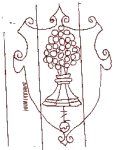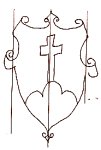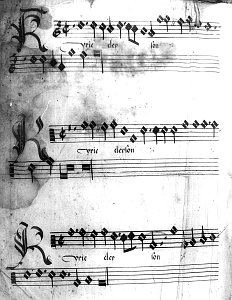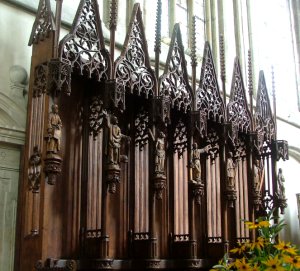
Kutna Hora's codex
This source is different from the previous ones. It is about 100 years younger and contains sacramental ordinaries composed in the style of the late Renaissance polyphony. The source is deposited in the collections of the Czech Museum of Music under the signature AZ 33. It contains 261 paper folios, 57,5 x 43,5 x 8cm. It is bound in a cardboard cover. The binding is late Renaissance. All this information comes from Jan Baťa's works [1, 2].


 According to the filegrees the age of the paper is dated between 1568 – 1590. The manuscript itself may have been written gradually between 1470 – 1490. It was written by two scribes in white mensural notation.
According to the filegrees the age of the paper is dated between 1568 – 1590. The manuscript itself may have been written gradually between 1470 – 1490. It was written by two scribes in white mensural notation.
The source contains 11 complete Catholic sacramental ordinaries in the form of a choir book (chorbuch). In this regard it is a very unique source in Bohemia. The masses are written by parodic technique (they use already existing compositions – both foreign or own), which is characteristic for compositions of that period.
The following chart contains the list of compositions:
The first two masses are anonymous, however, similar sources suggest that Phillipe de Monte is the author.

Writer hand A - fol. 1 v
(Ph. de Monte: Missa Septimi toni)

Writer hand B - fol. 155v
(G. Flori: Missa super Ecco ch´io lass´il core)
The problem of provenience of the source:
The note on the front page provides information about the location and donor (which is not very frequent for documents of that time). The Latin inscription in humanistic semi-italics in the upper right-hand corner says the following:
"Chori Templi Diui Iacobi Majoris Gutte[n]berga. Ex dono D[omini] Sigismundi Kozel a Rey: sentol. Sacra Casara Majestatis Rei Metallica olim hic Gutte[n]berga prafecti, et postea ejusdem Reipublica Gutte[n]bergensis Primatis"
which means in translation:
To the choir of St James the Taller in Kutná Hora. As a gift of Sir Zikmund Kozel of Rýzentál, the reeve of the Imperial Majesty in Kutná Hora, and later also mayor.”
Zikmund Kozel z Rýzntálu (1548 - 1598), a rich member of the town’s elite, is especially known as the donor of the school at St James. What his role was in acquiring this source and how it ended in Kutná Hora is very unclear and it is a matter of further investigation.



The source contains 11 complete Catholic sacramental ordinaries in the form of a choir book (chorbuch). In this regard it is a very unique source in Bohemia. The masses are written by parodic technique (they use already existing compositions – both foreign or own), which is characteristic for compositions of that period.
The following chart contains the list of compositions:
| Folio | Author | Composition | Voices | Pattern |
| 1v-23r | Philippe de Monte | Missa quinque vocum | 5 | |
| 24v-48r | Philippe de Monte | Missa super Cara la vita mia | 6 | G. de Wert: Cara la vita mia |
| 49v-67r | Charles Luython | Missa super Filiae Hierusalem | 6 | Ph. de Monte: Filia Hierusalem |
| 68v-86r | Philip Schöndorff | Missa super La dolce vista | 6 | Ph. de Monte: La dolce vista |
| 87v-119r | Giorgio Flori | Missa super Ung jour l´amant | 8 | O. di Lasso: Ung jour l´amant |
| 120v-154r | Philippe de Monte | Missa Confitebor tibi Domine | 8 | O. di Lasso: Confitebor tibi Domine |
| 155v-176r | Giorgio Flori | Missa super Ecco ch´io lass´il core | 6 | anon.: Ecco ch´io lass´il core |
| 176v-195r | Philippe de Monte | Missa sine nomine | 6 | |
| 195v-210r | Philipp Schöndorff | Missa Usquequo Domine | 6 | Ph. de Monte: Usquequo Domine |
| 210v-237r | Jacob Regnart | Missa super Poi che´l mio largo pianto | 6 | Ph. de Monte: Poi che´l mio largo pianto |
| 237v-261r | Giulio Belli | Missa super Tanto tempore vobiscum sum | 8 | G. Belli: Tanto tempore vobiscum sum |
The first two masses are anonymous, however, similar sources suggest that Phillipe de Monte is the author.

Writer hand A - fol. 1 v
(Ph. de Monte: Missa Septimi toni)

Writer hand B - fol. 155v
(G. Flori: Missa super Ecco ch´io lass´il core)
The problem of provenience of the source:
The note on the front page provides information about the location and donor (which is not very frequent for documents of that time). The Latin inscription in humanistic semi-italics in the upper right-hand corner says the following:
"Chori Templi Diui Iacobi Majoris Gutte[n]berga. Ex dono D[omini] Sigismundi Kozel a Rey: sentol. Sacra Casara Majestatis Rei Metallica olim hic Gutte[n]berga prafecti, et postea ejusdem Reipublica Gutte[n]bergensis Primatis"
which means in translation:
To the choir of St James the Taller in Kutná Hora. As a gift of Sir Zikmund Kozel of Rýzentál, the reeve of the Imperial Majesty in Kutná Hora, and later also mayor.”
Zikmund Kozel z Rýzntálu (1548 - 1598), a rich member of the town’s elite, is especially known as the donor of the school at St James. What his role was in acquiring this source and how it ended in Kutná Hora is very unclear and it is a matter of further investigation.
CANTICA srpen 2005. Kontakt: kafka@email.cz






